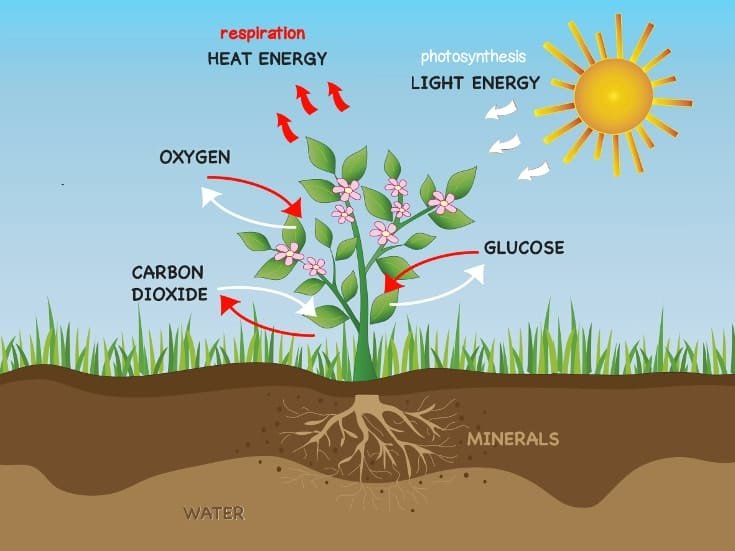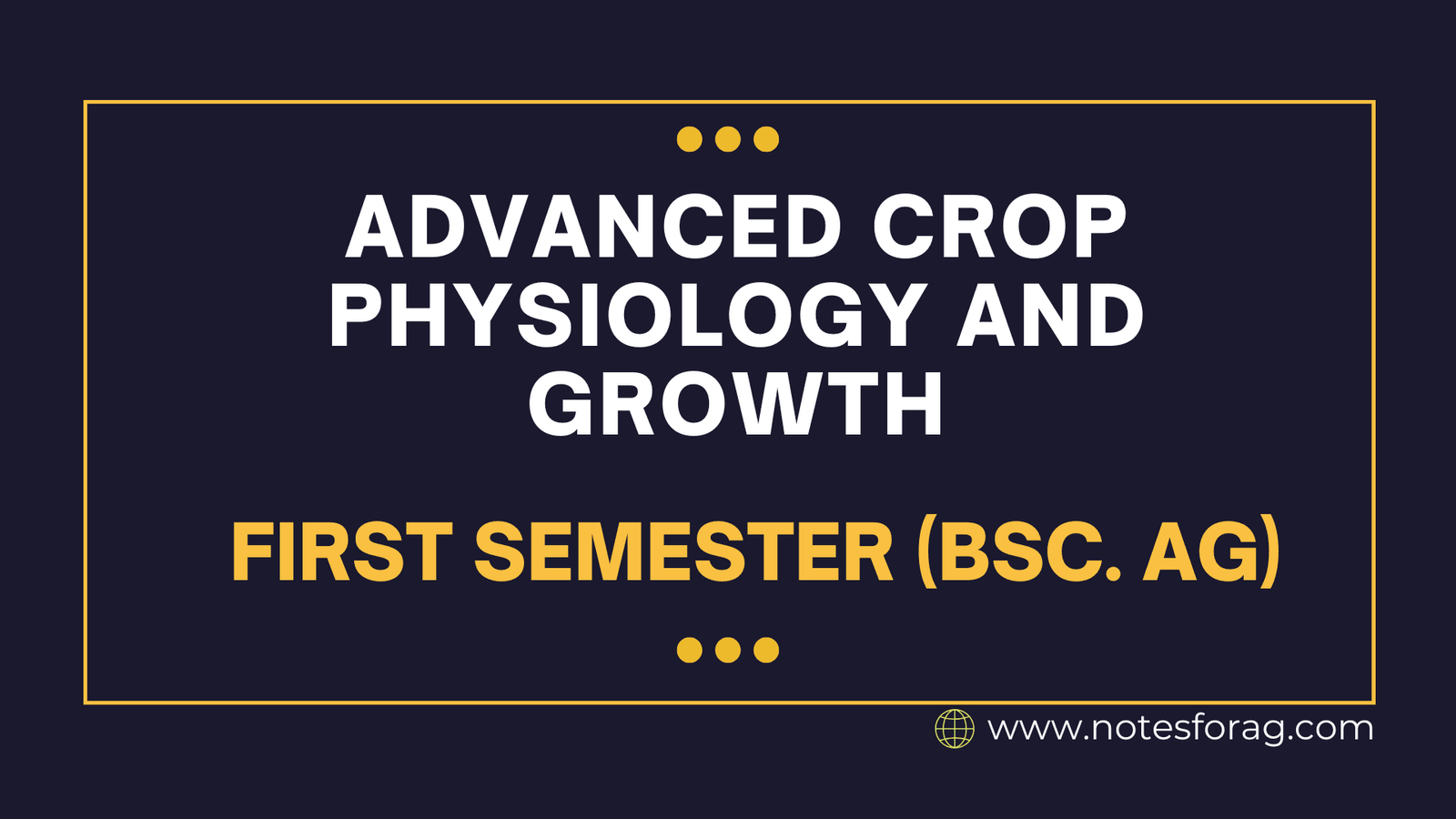Crop physiology is the study of the internal functions and processes that underpin plant growth and development. It integrates genetic, biochemical, and environmental perspectives to understand how plants convert energy, regulate metabolism, and respond to stresses. A deep understanding of crop physiology is critical to enhancing yield, resource efficiency, and stress resilience in modern agriculture. This discussion explores the main factors influencing crop growth, delves into the mechanisms of photosynthesis and respiration and their role in water‐use efficiency (WUE), and highlights how plant growth regulators (PGRs) are used to manage and improve crop performance.

Table of Contents
Factors Influencing Crop Growth and Development
Plant growth and development are the result of a complex interplay between intrinsic genetic controls and external environmental factors. Key determinants include:
Environmental Conditions
Light, temperature, water availability, and nutrient supply play essential roles. Light intensity and quality drive photosynthesis, while temperature influences enzyme activity and metabolic rates. Water availability not only affects photosynthetic gas exchange through stomatal regulation but also impacts nutrient transport. Nutrient status is vital for building biomass, as deficiencies or imbalances can constrain growth and reduce yields.
Soil and Climate
Soil properties such as texture, organic matter content, and pH—affect root growth and nutrient uptake. Climate change introduces additional challenges including erratic rainfall, increased temperatures, and extreme weather events that alter growth cycles and stress dynamics.
Genetic Makeup and Breeding
Crop genetics determine inherent growth rates, stress tolerance, and the efficiency of physiological processes. Through conventional breeding and modern molecular techniques, scientists select for traits such as drought resistance, enhanced photosynthetic capacity, and optimal resource use.
Agronomic Practices
Cultural practices including planting density, irrigation, fertilization, and crop rotation significantly influence crop performance. For instance, optimizing row spacing can improve light interception and reduce soil evaporation, thereby enhancing overall water‐use efficiency.
Together, these factors interact to determine the yield potential and adaptability of crops, making it imperative that integrated management strategies are employed to optimize plant growth.
Photosynthesis

Photosynthesis is the cornerstone of plant productivity. This process converts light energy into chemical energy through a series of light-dependent reactions and the Calvin cycle (light-independent reactions). In the light reactions, chlorophyll and accessory pigments absorb sunlight to generate ATP and NADPH, which then drive the fixation of atmospheric CO₂ into sugars during the Calvin cycle. Key enzymes such as ribulose-1,5-bisphosphate carboxylase/oxygenase (Rubisco) play a central role in catalyzing CO₂ fixation; however, Rubisco is known for its dual affinity for oxygen, leading to photorespiration a process that can reduce overall photosynthetic efficiency.
Plants have evolved several mechanisms to enhance the efficiency of photosynthesis, including modifications in leaf anatomy, chlorophyll content, and even alternative biochemical pathways in certain species (e.g., C₄ and CAM plants). These adaptations help maximize carbon assimilation under varying light, temperature, and CO₂ conditions.
Respiration

While photosynthesis builds biomass by capturing carbon, respiration breaks down sugars to release energy for cellular activities. There are two types of respiration in plants:
Growth Respiration: Associated with the synthesis of new biomass.
Maintenance Respiration: Involves energy expenditure for maintaining cellular integrity, ion gradients, and repair processes.
The balance between photosynthesis and respiration determines the net energy available for growth. High respiration rates especially under stress conditions can limit biomass accumulation. Therefore, optimizing respiration is critical for improving crop productivity. Strategies that reduce unnecessary energy loss while maintaining essential cellular functions contribute to higher net photosynthetic output.
Water-Use Efficiency (WUE)
Water‐use efficiency is defined as the ratio of biomass (or grain yield) produced per unit of water used (transpired) by the crop. It is a crucial trait under water-limited conditions and is influenced by both photosynthetic performance and stomatal behavior. When stomata open to allow CO₂ uptake, water vapor is simultaneously lost. Therefore, achieving high WUE depends on a plant’s ability to balance these processes. Plants can enhance WUE through:
Stomatal Regulation
Optimizing the opening and closing of stomata to maintain CO₂ uptake while minimizing water loss. Under elevated CO₂ conditions, many crops exhibit reduced stomatal conductance, thereby conserving water without a proportional loss in photosynthesis.
Anatomical Adaptations
Leaf structures such as a thicker cuticle, reduced leaf area, or sunken stomata can reduce transpiration.
Biochemical Adjustments
Improvements in photosynthetic enzymes and pathways can increase the carbon gain per unit of water lost. Advanced breeding and genetic engineering efforts aim to narrow the gap between current WUE and the theoretical maximum.
Overall, an integrated understanding of photosynthesis, respiration, and WUE not only helps in selecting and breeding more efficient crop varieties but also informs agronomic practices such as precision irrigation and nutrient management.
Role of Growth Regulators in Crop Management
Plant growth regulators (PGRs) are natural or synthetic hormones that influence plant development at very low concentrations. They are critical in managing crop growth, stress responses, and developmental processes. Major classes of PGRs include:
Auxins
These hormones (e.g., indole-3-acetic acid) are pivotal in cell elongation, apical dominance, and root initiation. Auxins are used to promote rooting in cuttings and can be applied to enhance fruit set and control plant architecture.
Gibberellins (GAs)
Known for their role in stem elongation, seed germination, and flowering, gibberellins can stimulate growth in dwarf varieties and are used to modify plant stature to prevent lodging (the bending over of plants).
Cytokinins
These hormones promote cell division and are often associated with delaying leaf senescence, improving nutrient mobilization, and enhancing shoot growth. Their application can increase yield by maintaining green leaf area for extended periods.
Abscisic Acid (ABA)
Often referred to as the stress hormone, ABA is involved in stomatal closure during drought stress and helps plants conserve water. While high levels of ABA can limit growth, controlled applications can improve drought tolerance.
Ethylene
A gaseous hormone, ethylene influences fruit ripening, leaf abscission, and stress responses. Manipulating ethylene levels is important in synchronizing fruit ripening and extending the shelf life of harvested crops.
Brassinosteroids
These steroids enhance cell expansion and division, improving overall plant growth and stress tolerance. Their application can lead to increased yields, particularly under adverse environmental conditions.
In crop management, the precise application of growth regulators allows farmers to manipulate developmental stages, improve stress responses, and optimize resource allocation. For example, applying cytokinins may delay leaf senescence during critical growth phases, thus extending the photosynthetically active period. Similarly, the use of ABA analogues during drought periods can help maintain water balance by promoting stomatal closure, while auxins can be applied to stimulate rooting and improve plant establishment.
Moreover, the development of synthetic growth regulators has provided tools to mimic or enhance natural hormonal functions. This is especially beneficial in situations where environmental stresses might disrupt the natural hormone balance. Integrating these regulators with modern agronomic practices can lead to more resilient crop systems and improved productivity in both optimal and stress-prone environments.
Conclusion
Advancements in crop physiology provide a detailed understanding of how various intrinsic and extrinsic factors converge to influence plant growth. The complex interplay between environmental conditions, photosynthetic efficiency, respiration, and water‐use efficiency ultimately determines crop yield and resilience. By harnessing this knowledge, agronomists and plant breeders can develop strategies to improve crop productivity. Plant growth regulators serve as powerful tools to fine-tune development and stress responses, enabling tailored management practices that maximize yield while conserving critical resources such as water. As global challenges such as climate change and resource scarcity intensify, continued research and the integration of advanced physiological insights into crop management will be essential for ensuring sustainable food production and long-term agricultural success.
Frequently Asked Questions (FAQ)
What factors influence crop growth and development?
Crop growth depends on environmental conditions (light, temperature, water, and nutrients), genetic traits, and agronomic practices like irrigation and planting density.
How do photosynthesis, respiration, and water‐use efficiency (WUE) interact?
Photosynthesis builds biomass while respiration uses energy; WUE measures how much biomass is produced per unit of water used. Balancing these processes improves yield, especially under drought.
What role do plant growth regulators (PGRs) play in crop management?
PGRs (such as auxins, gibberellins, cytokinins, ABA, and ethylene) control plant growth, stress responses, and development, allowing for improved crop structure and productivity.
Related Articles

